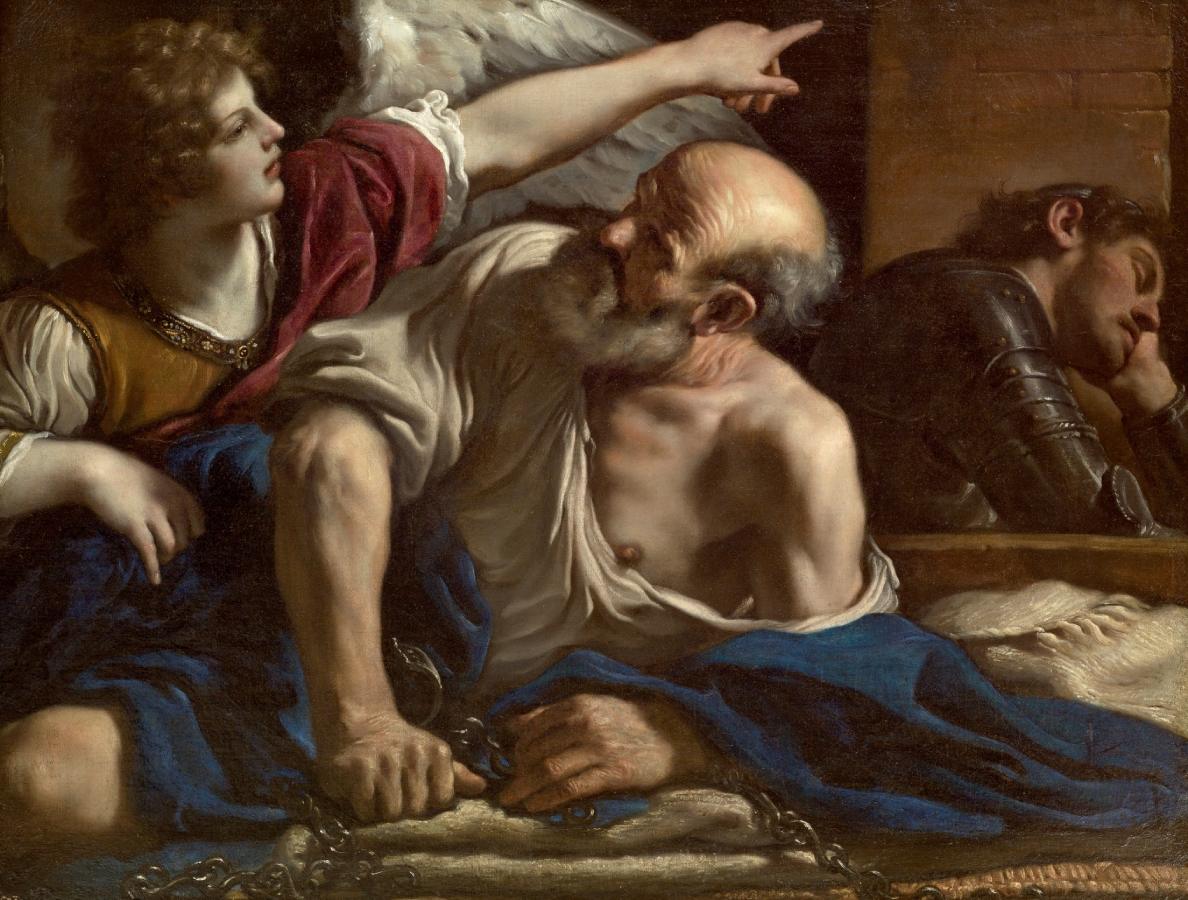Guercino (1591-1666)
San Pietro liberato da un angelo (Saint Peter freed by an Angel)
c.1622
Oil on canvas, 105 x 136 cm
Museo del Prado, Madrid
A youthful looking angel with curly hair imperiously points out the path of freedom to an astonished Saint Peter, depicted as a man of advanced age confined in a prison. In the background, clad in a suit of armour, the gaoler sleeps, impervious to what is going on behind his back. The two main figures are attired in vaguely classical dress: that of the angel is simple but sumptuous, in accordance with her celestial nature and ideal beauty, whereas the first pope is draped in tattered clothing owing to his precarious situation inside the dungeon. The episode is based on a supposed anecdote taken from the saint’s life. During the persecution of the apostles by Herod, when James the Great was executed, Peter was imprisoned. While he was asleep an angel appeared to him in his cell telling him to stand up and flee, which he did without being discovered. The episode symbolises the fact that the church will always be spared from enemy attacks. The composition unfolds completely in the foreground and the protagonists are depicted in great wealth of detail. Light penetrates the scene from the right of the canvas, powerfully illuminating it in such a way that the chiaroscuro skilfully spread across the surface of the canvas shapes a superb plastic expressivity that creates suitable volumes. This is a relatively early work and, like the painting of Saint Matthew and the Angel (Pinacoteca Capitolina, Rome), can be dated to halfway through Guercino‘s stay in Rome. Interestingly, despite the large number of drawings this artist made, so far it has not been possible to link any with absolute certainty to the Prado painting; however, all the technical and aesthetic features of the work are considered characteristic of Guercino during this period. It is reasonable to think that the Madrid painting is fully contemporaneous with The Burial of Saint Petronilla, which must have been executed in the first months of 1622 and beginning of 1623. Saint Peter displays a similar emphasis on the solidity of the images, which is accentuated by the powerful effects of light and shadow. It is surprising how here Guercino dispenses with unnecessary accessory elements that appeared to be one of the essential features of his works in a not much earlier state in his career. Another detail that should be stressed is the rich chromatic range of splendidly dramatic deep tones. Early sources do not mention the painter in relation to Spain; however, the artists’ biographer Malvasia comments in Felsina Pittrice (1678) that in Rome Guercino delivered paintings to the Capuchin Fathers, who, according to the text ‘a las Indias’, took with them on their missions to the Americas images of the Virgin that were considered miraculous in some places. No information has come to light to prove this, nor have originals or copies of these creations been discovered, if they did in fact exist -on account of their miraculous nature, they would have been popular, giving rise to more or less faithful copies painted by local artists. At the least, Velázquez stopped at Cento during his first trip to Italy, probably to meet the master, by then fairly famous. (De Tiziano a Goya: grandes maestros del Museo del Prado, Madrid, Museo Nacional del Prado: SEACEX, 2007, p.243)
